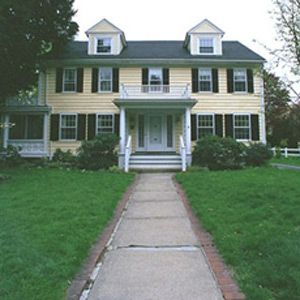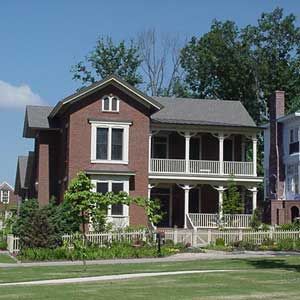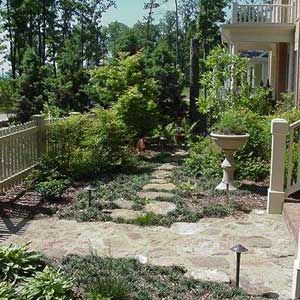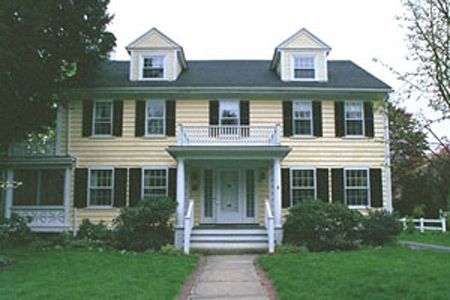
When This Old House chooses a project house, it’s only natural that we put all our energy into the task at hand—getting that house into shape for the homeowners to move in, or to move back in, as the case may be. The homeowners have a budget, the crew has a construction plan, and the television producers have a shooting schedule; we need to keep all those in mind as the work progresses. But, there’s even more to it than all that.
You’ll often see the homeowners on television with us, approving the plans, pitching in with the work, and making decisions along the way. What you don’t usually see is what’s going on in their lives outside the project. Is the project house their current home, or are they selling a previous home and getting this one ready for moving day? Where are they living while the work is going on? How are they holding up under the stress of a major renovation?
Kim Whittemore and Bruce Leasure, the owners of the Winchester project house, were new to their neighborhood, recent arrivals from Huntsville, Alabama. Being the new kids on the block feels familiar to them, as they were relative newcomers to Huntsville as well. They’d barely had time to settle into their brand-new home there when Bruce’s Huntsville-based employer was acquired by another company. Bruce and Kim decided to take a few months off on a well-deserved sabbatical in Puerto Rico—but their plans were interrupted on the third day by the offer of an exciting new position in Concord, Massachusetts. Bruce and Kim decided the opportunity was worth the move, and they headed north to look for yet another new home.
Bruce and Kim fell in love with Winchester the first time they drove through town. After a few weekends driving up and down the streets of the Flats, they spotted a new “For Sale” sign on a beautiful old Colonial Revival. They walked through the house with their real estate agent for 30 minutes on a Saturday, Kim spent another 15 minutes there on Monday, and that was enough. They made an offer, bought the house, and the rest is This Old House television history.
At the time we were working on the Winchester house, Kim and Bruce were also in the process of saying good-bye to their beloved home in Huntsville. As it turns out, the story of the house and neighborhood they’re leaving behind is almost as good as the ongoing tale of the renovation.

An Experiment in New Urbanism
The house Kim and Bruce are leaving was built in a picturesque development called The Ledges, a community planned in what’s come to be known as New Urbanism. New Urbanism, or Traditional Neighborhood Planning, got its start in the early 1980s in the town of Seaside, Florida (which earned a bit of additional fame as the setting for the movie “The Truman Show”). Seaside was designed around an old-fashioned premise — people want to live in small-town settings, with local shops and services, that don’t require a car for every errand.
The Ledges sits on a mountaintop plateau overlooking Huntsville. The plateau has spectacular views in all directions, and the natural topography of the area forms the different ‘rooms’ of the development. A world-class golf course establishes a perimeter and protects the views of the valley.
The Ledges was inspired by historic settlements in Alabama, including nearby Twickenham and Mooresville. Neighborhood shops, village greens, and tree-lined streets provide natural focal points for those towns, and that concept is apparent in the four distinct neighborhoods within The Ledges — Crest Park, Cumberland Estates, The Highlands, and Twickenham Village.
The four neighborhoods within The Ledges adhere to New Urbanism principles in that they are compact, mixed-use, and walkable. All feature the open green spaces, sidewalks, gas streetlights, and other historic touches that made the original towns so appealing. Front porches encourage daily conversations among neighbors and between homeowners and passersby. A village center offers a clubhouse, shops, and a variety of local conveniences within walking distance of all four neighborhoods. Local stores have living space above them, just as traditional town centers did.
The 4-bedroom, 3.5-bath house Kim and Bruce are leaving behind is in the village of Crest Park. It’s a reproduction 1860s Victorian Italianate home that was designed by local architect Bill Peters. Kim and Bruce bought the house from the builder when it was about 75 percent complete, so they were able to select the finishing touches themselves. The finished product shows their respect for tradition as well as their quest for modern conveniences. Kim lovingly describes how she and Bruce made their choices, from the quartersawn oak hardwood flooring throughout the house (stained a mixture of dark walnut and ebony to achieve a dark, aged appearance) to the white Carrara marble surfaces in the kitchen, butler’s pantry, and all the bathrooms.

Leaving the Ledges
The kitchen in the house is a work of art in itself, and is the heart of the home.
Its professional-grade appliances include a Sub-Zero refrigerator/freezer and Bosch dishwasher, disguised by cabinets from Quality Custom Cabinetry in American Cherry finish. The butler’s pantry wet bar cabinetry hides the icemaker, while cabinetry above the marble countertop has glass doors for display of stemware. The visible appliances, including a combined convection/microwave oven and a gas range with electric oven (both Thermador), as well as sinks and faucets, are in stainless steel with a satin nickel finish for simplicity and consistency.
The kitchen sink is modeled after an old basin with integrated drain board. Puk lights hidden under the cabinetry illuminate the kitchen and wet bar counters. The center island and adjoining pantry/laundry room surfaces are done in traditional butcher block, with state-of-the-art Asko washer and dryer under-mounted to provide more counter space. (Bruce picked the Asko washer and dryer in stainless steel so they would match the exposed stainless appliances in kitchen.) And despite a large adjoining dining room, Kim reports that “everyone parks on the old English pub stools at the center island. We often don’t even make it to the dining room at all, people seem so comfy cozy in the kitchen.”
So it was with mixed feelings that Kim and Bruce put the house on the market. They’re hoping to sell it right around the time that work on the Winchester house is complete, but anyone who’s completed a sell one/buy one transaction knows that the timing rarely works out quite that neatly.
While the Winchester house is under renovation, Bruce and Kim are living in an extended-stay hotel in Waltham. They have a small two-bedroom unit with a kitchenette and living room, space they share with their Labrador retrievers. They report that it’s actually quite cozy, although they’re looking forward to living in one place again. During the construction, their furnishings and everything else except some clothing and files remain in Huntsville, and they’re racking up a lot of air miles flying back and forth between homes.
A recent trip back to the Huntsville house was bittersweet—many new neighbors had completed their homes and moved in, and the landscape was lush and still in bloom. “I miss the front porch rockers,” says Bruce, “and neighbors just stopping by to ‘set a spell.’ And Kim is suffering from plant withdrawal — she planted 1,500 bulbs in the yard this time last year!”
Not that they have any real regrets—Kim and Bruce are in love with their new home in Winchester and are looking forward to moving in when the project is complete. In fact, they see a lot of similarities between The Ledges in Huntsville and the Flats section of Winchester. “The original planners of the Flats 100 years ago were ahead of their time,” says Kim. “Their people-friendly development standards probably just seemed like common sense to them. Now we call it New Urbanism!”
For more information:
For more information about Huntsville, visit huntsville.org
For more information about The Ledges, visit theledges.com
For more information about New Urbanism, visit www.newurbanism.org

